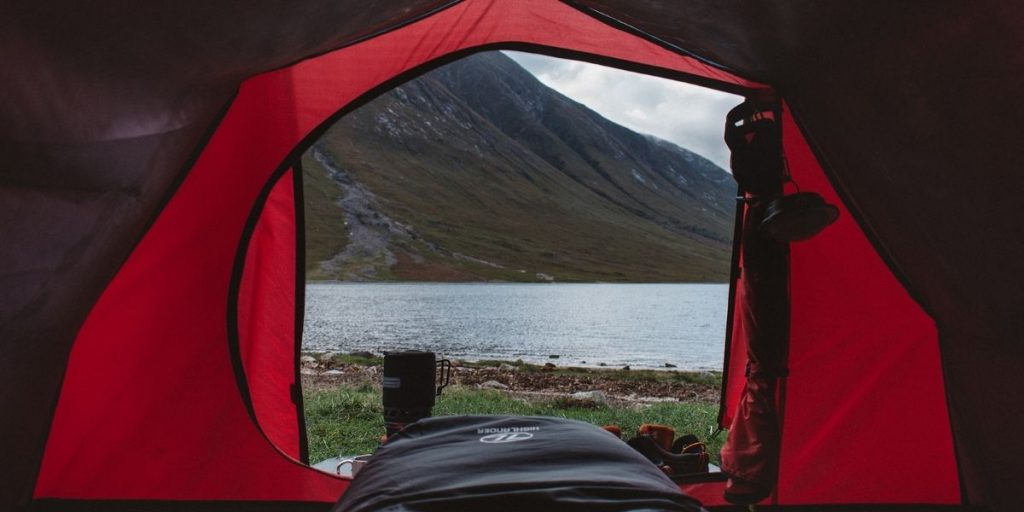![]() When buying a tent, it is important to find out how much water the tent can hold. The tent is your base when you are on a trip. It is therefore essential that the tent keeps you and your pack dry, even if you get caught in heavy rain.
When buying a tent, it is important to find out how much water the tent can hold. The tent is your base when you are on a trip. It is therefore essential that the tent keeps you and your pack dry, even if you get caught in heavy rain.
In the article below, we will guide you in water column pressure and tent materials, so you can become wiser about your tent’s waterproofness .![]()
What is water column pressure?
Water column pressure is an expression of how high the water pressure of a given material can withstand before the water passes through the material. It can be tested by unfolding a material with a cylinder fixed on top. Then fill the cylinder quietly with water until it can be seen that water passes through the material. Once the water has passed through, it is the height of the cylinder that determines the water column pressure on the material.
However, there is a difference between the material of a tent and the material of, for example, rainwear. The tent’s outer material places fewer demands on the waterproofness than the rainwear . It does this because the water will run down the sides of the tent when it hits the tent – if the tent is set up properly. The outside of the tent will therefore not be exposed to a pressure, which means that the water will pass through the material, as will apply to rainwear, for example, where an increased pressure is created on the rain pants if you sit down.
How waterproof should a tent be?
If the tent has a water column pressure of 1,500 mm, it can be described as waterproof. That’s the rule of thumb . However, you can advantageously examine the tent’s material and construction rather than just looking at the water column pressure, due to the water’s ability to find its way away from the outside of the tent.
Tents have different materials, which will have varying lifetimes. This is a contributing factor to the fact that you need to look for something other than the water column pressure. If you buy a cheap or medium-expensive tent, it has a PU coating on the back of either nylon or polyester, which is what makes the tent waterproof. The disadvantage of PU coating is that over time it will degrade and thus no longer be waterproof. PU coating can vary in thickness and quality, which will be reflected in the price of the tent. If you have often used your tent in high sun, or if it has not been cared for or stored appropriately, it will have a negative effect on the PU coating, which will therefore contribute to a poorer waterproofness.
If you choose to buy a tent at the most expensive end of the price scale, silicone is most likely used to make the tent waterproof. This is done with a technique where the silicone is applied to the front and back of nylon material in strong quality. Thereby the silicone lies between the nylon fibers and together they create a waterproof surface. The silicone is thus a part of the material which cannot absorb water.
![]()
Waterproof tent base
When choosing a tent, in addition to the outer material, focus on the bottom of the tent. It is recommended that the bottom of the tent has a higher water column pressure than the rest of the tent, as the bottom is exposed to high pressure when you stay in the tent.
The tent base must have a minimum water column pressure of 5,000 mm . If you primarily use the tent in Denmark or the Nordic countries, it is recommended that the bottom water column pressure is even higher.
In addition, it is essential that the bottom of your tent is made of a durable material so that it can withstand being beaten up on hard or rough surfaces. It is difficult to avoid that there are small stones or something else where you pitch your tent, which will wear on the bottom.
You can also choose to bring a footprint for your tent. It is a specially designed pressing, which acts as a protective layer between soil and tent. You should be aware that it is important to choose a footprint that fits the dimensions of your tent. If it is too large, there may be water around your tent, which in the worst case can run into the tent.
If you are in doubt about which tent to choose, you can read our guide to choosing a tent here .

Take good care of your tent
Your tent has lots of trips in it if you take good care of it . Take care of your tent by using and storing it as best you can. You also maintain the waterproofness as best as possible with optimal tent care.
Four tips for optimal tent care
- Make sure the tent is properly dry before packing it
- Clean the tent before unpacking. It is recommended to do it more thoroughly occasionally
- Avoid condensation by ventilating well in the tent
- Store your tent dry and at room temperature when not in use




